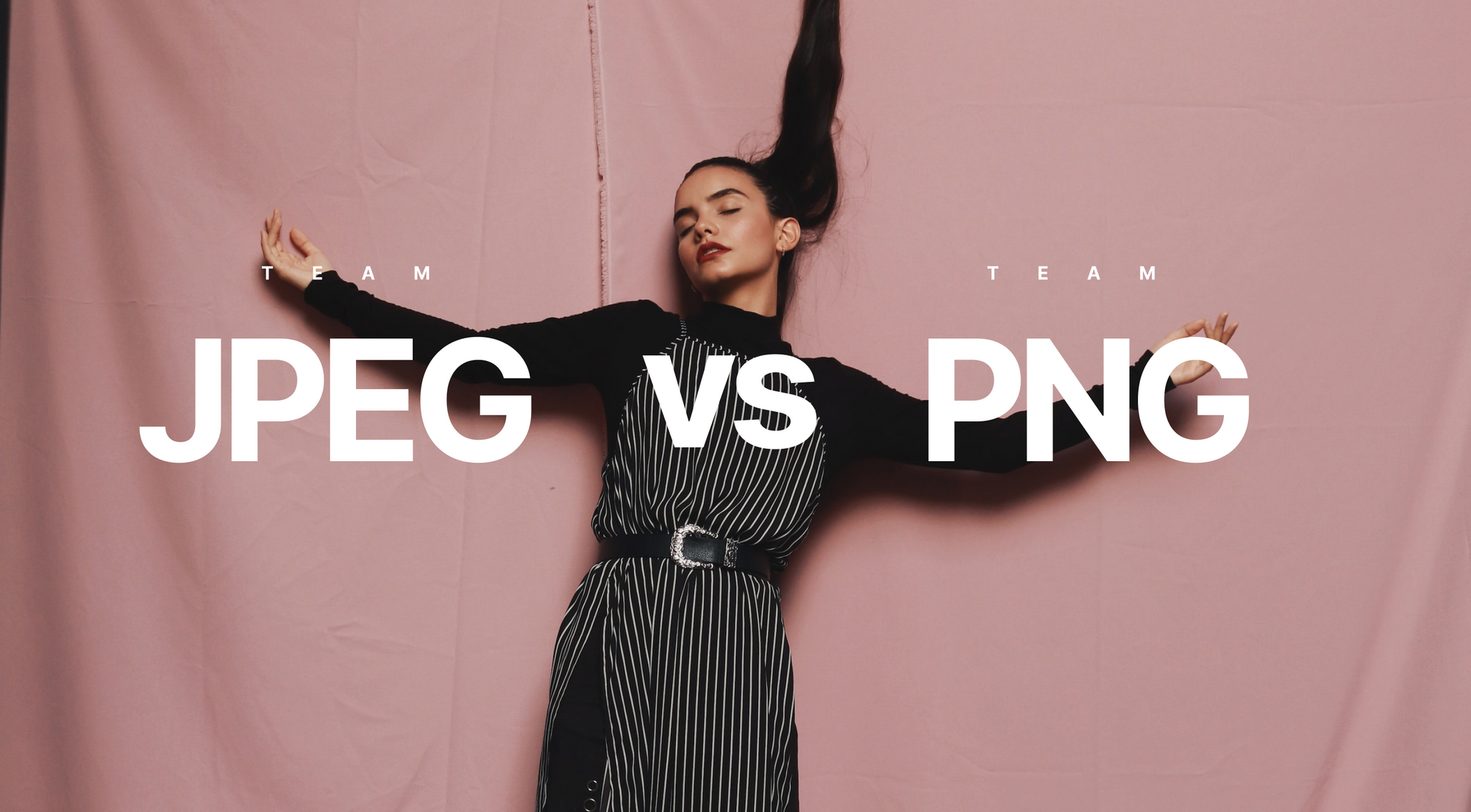JPEG and PNG are the two most common image formats. Learn what are the advantages of each for web, print, or photography.
Key takeaways
- JPEG is better to use for processing and storing full-color realistic images, storing and transmitting digital graphic content and hosting and transmitting compressed images over the network.
- PNG is an ideal format for webmasters due to its optimal compression without quality loss, fast loading, transparency features, and clear image borders. PNG is best suited for saving images with fewer colors and graphics with transparent areas, such as logos, icons, badges, diagrams, and scanned copies of documents.
- Both JPEG and PNG formats allow you to get image sizes that have optimal quality/file size ratios.
- Most browsers are configured to accept images in JPG and PNG formats, and some don't even display images in other formats.
- Even JPEG in 100% quality will experience some loss in quality compared to PNG and other lossless formats.
Pros and Cons of the JPEG Format
JPEG (same as JPG) is one of the most recognizable image formats.
This format was developed by the Joint Photographic Experts Group. The main task of this group of developers was to develop an optimal image compression algorithm.
The functionality listed below led to the tremendous popularity of the format.
Pros:
- High and manageable compression ratio. The user themselves choose the quality/file size ratio
- Small file size
- Support by all browsers, graphic and text editors, compatibility and correct display on all computers, tablets, and mobile devices
- Works for full-color realistic images, where there are many color and contrast transitions
- With a small degree of compression, the image quality remains quite high
Cons:
- With strong compression, the image can "crumble" into separate squares - blocks of pixels 8x8 in size. This is because the compression algorithm analyzes neighboring pixels and calculates their color and averages. Due to this, smoother color transitions can become stepped or disappear altogether
- Worse than other formats for working with texts or monochrome graphic images with clear boundaries
- Does not support transparency. In the case of rendering templates, logos, and buttons, this is critical
- it's not recommended to edit and/or resave JPEGs - such steps degrade the image quality
Where is JPEG used?
JPEG is most often used for processing and storing full-color images with realistic images, where brightness and color transitions are inherently present. Also, the JPEG format is used for storing and transmitting digital graphic content (photos, scanned copies, digitized pictures). It is also convenient for hosting and transmitting compressed images over the network because it takes up little space compared to most formats.
Understanding JPEG quality
A low-quality image results in a smaller JPEG file, while a high-quality one generates a larger file. This is what makes JPEG different from lossless image formats such as PNG, BMP, and PPM. With these formats, the quality never degrades.
The amount of JPEG compression is measured as a percentage of the quality level. An image at 100% quality has (almost) no loss, and 1% quality is a very low-quality image. Quality levels of 90% or higher are considered to be "high quality," while 80%-90% is "medium quality," and 70%-80% is low quality.
Note: even JPEG in 100% quality will experience some loss in quality compared to PNG and other lossless formats.
Features of the PNG format
PNG is one of the most-used formats in web graphics. It was proposed in 1995 at the Usenet conference as a free alternative to the licensed GIF. Since October 1, 1996, it has existed as a full-fledged graphic format supported by almost every browser and graphic editor.
Some key functionality of PNG includes:
- Does not lose quality during compression. Therefore it is used to store images containing text: screenshots, drawings, scanned text, and comics.
- The algorithm compresses objects with horizontal lines better than those with vertical lines - single-color icons and icons, horizontal dividing lines.
- Surpasses JPEG and GIF in quality of color display, but the file size will be larger.
- High-quality transparency is implemented, so it is customary to store logos in PNG.
- Supports gamma correction - a function to compensate for brightness and color changes when viewing an image on different screens.
Advantages and disadvantages of the PNG format
Pros:
- Image quality does not change with any degree of compression
- Convenient for storing intermediate versions of an image - after editing and resaving, the quality does not deteriorate
- Preserves a high-contrast pixel-by-pixel image of the screen in screenshots without merging neighboring pixels together
- Supports the maximum possible number of colors: 256 colors for web graphics (PNG-8), 16 million colors for full-color images (PNG-24), as well as images in grayscale
- Supports multi-level transparency, thanks to which you can create a transparent gradient, the effect of casting a shadow on adjacent elements on a web page. Logos in PNG to conveniently overlay multi-color images, drawings, photos
- Keeps web graphics small, which makes websites load faster
- Allows you to work with layers
Cons:
- Saves full-color images — photos, illustrations — larger than the equivalent JPEG, TIFF or GIF
- Does not support animation
- Not suitable for printing, as it is intended for the distribution of images on the internet and does not support the CMYK color model.
Where to Use the PNG Format?
PNG is a favorite format of webmasters due to its optimal compression without quality loss, fast loading, transparency features, and clear image borders. In practice, PNG is best suited for saving images with fewer colors and graphics with transparent areas. Logos, icons, badges, diagrams, and scanned copies of documents are usually placed on websites in PNG format.
So which Format to Choose for the Web?
Although there are many image formats, PNG and JPEG have a number of advantages:
- High-quality compressed images — both JPEG and PNG formats allow you to get image sizes that have optimal quality/file size ratios.
- Small image file size.
- Excellent browser integration — most browsers are configured to accept images in JPG and PNG formats, and some don't even display images in other formats.
No one is forcing you to only use JPEG or PNG. But working with these formats helps facilitate the work of the webmaster and allows you to get the best performance out of a site via having to transmit a minimal amount of data over the network.
Note: Some image CDNs automatically adjust and deliver images based on device's screen size and page layout. If your website hosts images on such CDN, you can upload them in high quality PNG without worrying that it will compromise the loading speed.
JPEG VS PNG for Print
PNG is best for drawings, diagrams, icons, logos, or in cases where transparency is needed for the image. But if you need to print out an image with lots of colors and gradients, both JPEG and PNG can work. It all comes down to whether you want to save disk space and bandwidth with JPEG or get a little bit of extra quality with PNG.
However, despite the fact that the quality of a JPEG image is considered to be quite good, it still may not always meet the requirements of printing: what looks great on a computer monitor may look very different once it is printed out.
Tip: Use LetsEnhance.io to clean up JPEG artifacts and improve image quality for print. Our default upscale type, Smart Enhance, is a perfect tool for this job.
It is important to consider the size of the images you want to print to get a good result on paper.
JPEG VS PNG for Photography
JPEG files are extremely popular among photographers and companies that work with large image libraries. A smaller file size allows you to send and download multiple digital photos at the same time. JPEG files allow users to make efficient use of disk space, optimize libraries, and they don’t take much time to open.
JPEG files are very common and can be viewed and edited in many operating systems and programs, so you don't need specialized software to work with this file type.
PNG-8 files are not suitable for storing high-quality photos. However, PNG-24 is as good format for photographs as JPEG. Moreover, it works even better if your image contains transparency. But note that PNG‑24 files are often much larger than JPEG files of the same image.
In a Nutshell
So how to define when to use a JPEG or PNG?
JPEG is ideal in the following cases:
- Complex images — a slight loss in image quality in JPG format is hardly noticeable in pictures with a large number of objects and complex shapes, such as photographs. Therefore, you can get a smaller image size without losing the visual effect.
- Photo albums — to demonstrate a large number of photos, it is definitely worth using the JPG format. Fast loading and acceptable quality will help keep your visitor on the pages of the site.
- Opaque images — if your pictures don't have transparent areas, then you should use the JPEG format to achieve a smaller file size.
PNG format should be used with:
- Images with clear lines and text. In such pictures, pixelation will be especially noticeable. Therefore, you need to use a format that avoids this unpleasant effect and maintains a high level of file compression.
- Portfolio of works — to demonstrate a high level of professionalism, you need to present your work in a favorable light. Therefore, the quality of the image must be maintained.
- Transparent areas of the image — in such cases, the PNG format will definitely help.
Some site owners choose only one format for their projects. But it is worth considering the advantages of JPEGs and PNGs in each case to achieve an optimal speed and quality ratio.


